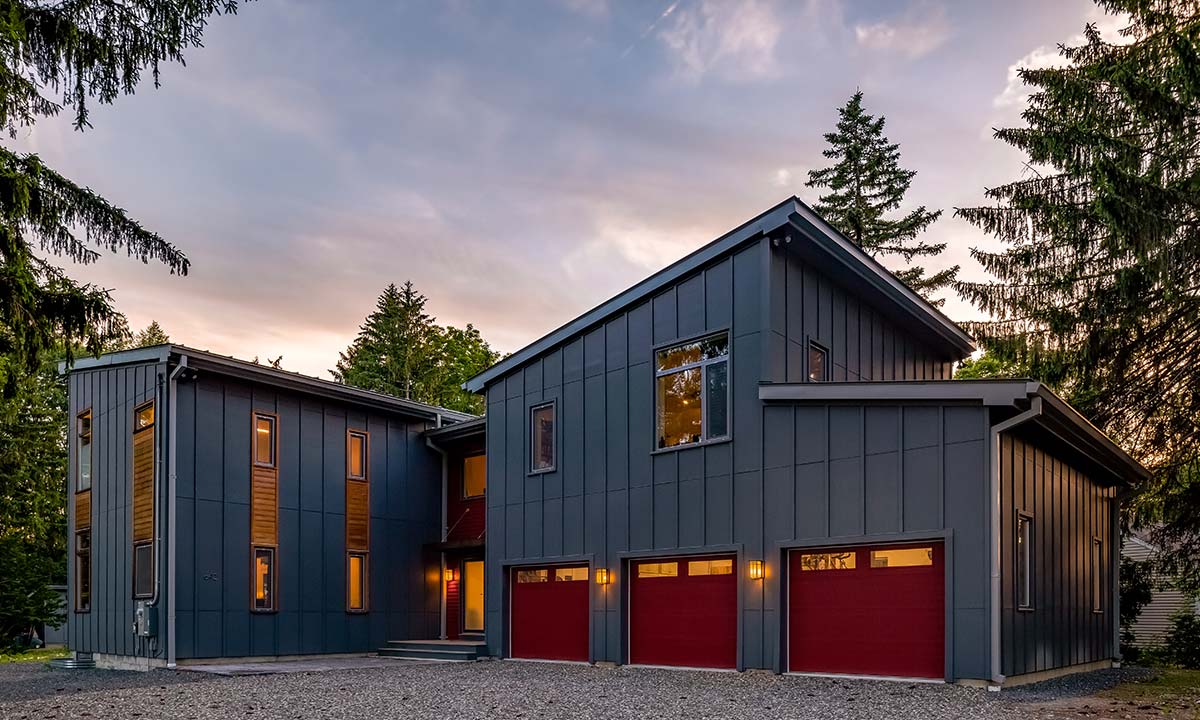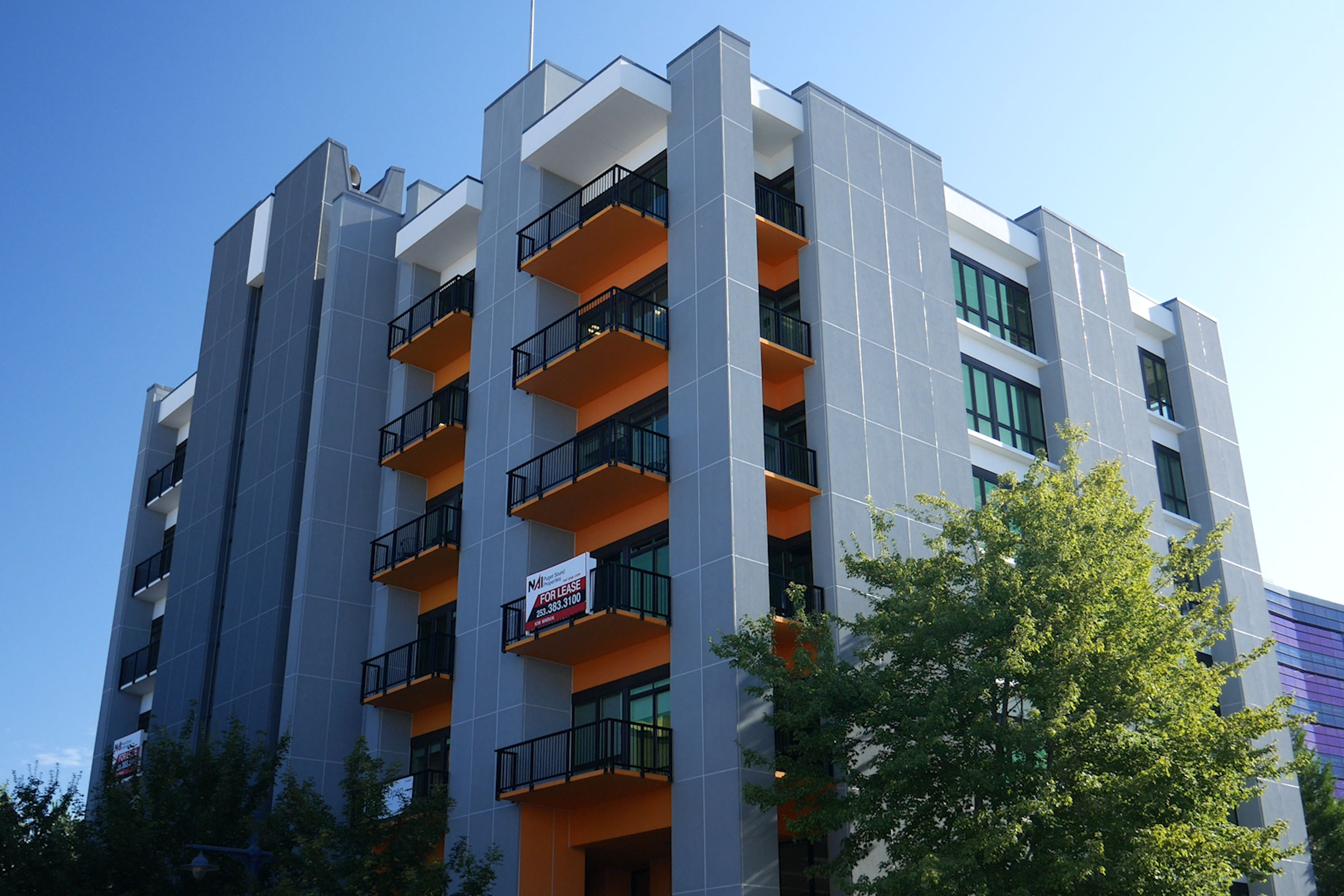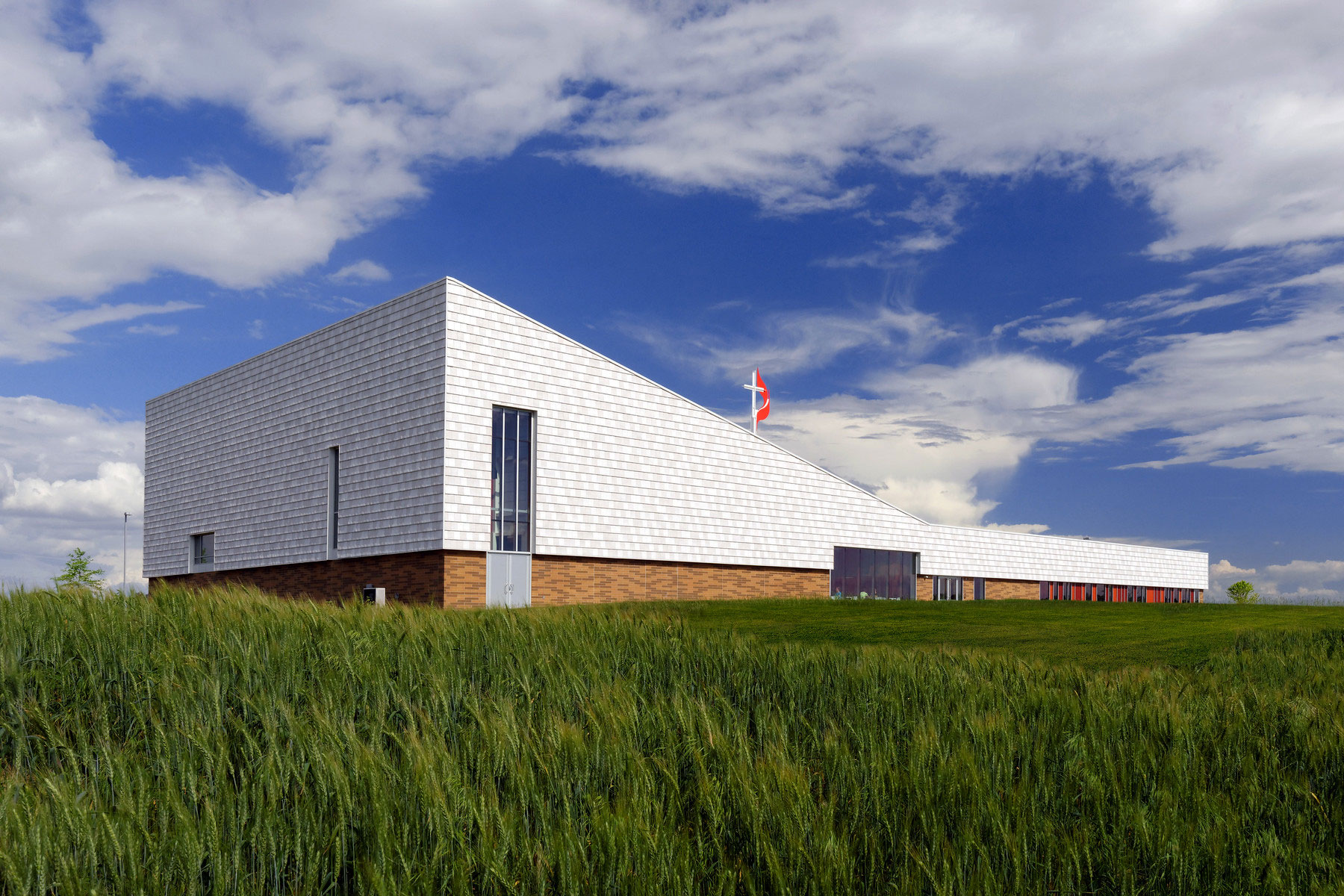Story at a glance:
- Net zero is achieved when greenhouse gas emissions are as close to zero as possible.
- Reaching net zero globally by 2050 is crucial to keeping global warming below 1.5℃.
- Transitioning to renewable energy sources is an effective way to reduce emissions and achieve net zero.
The science is undeniable. Our climate is changing at a rapid rate, and our greenhouse gas emissions are to blame. As the planet continues to warm, sea levels rise, and extreme weather events become more frequent and severe, it’s become more apparent than ever that emissions across all sectors must be drastically reduced to avoid total climate catastrophe.
Achieving net zero—or balancing emissions produced with those removed from the atmosphere—by the year 2050 is key to keeping global warming below the 1.5℃ tipping point. These are the basics of net zero, including pathways and strategies to reach net zero and a few examples of what net zero looks like in the built environment.
What is Net Zero?
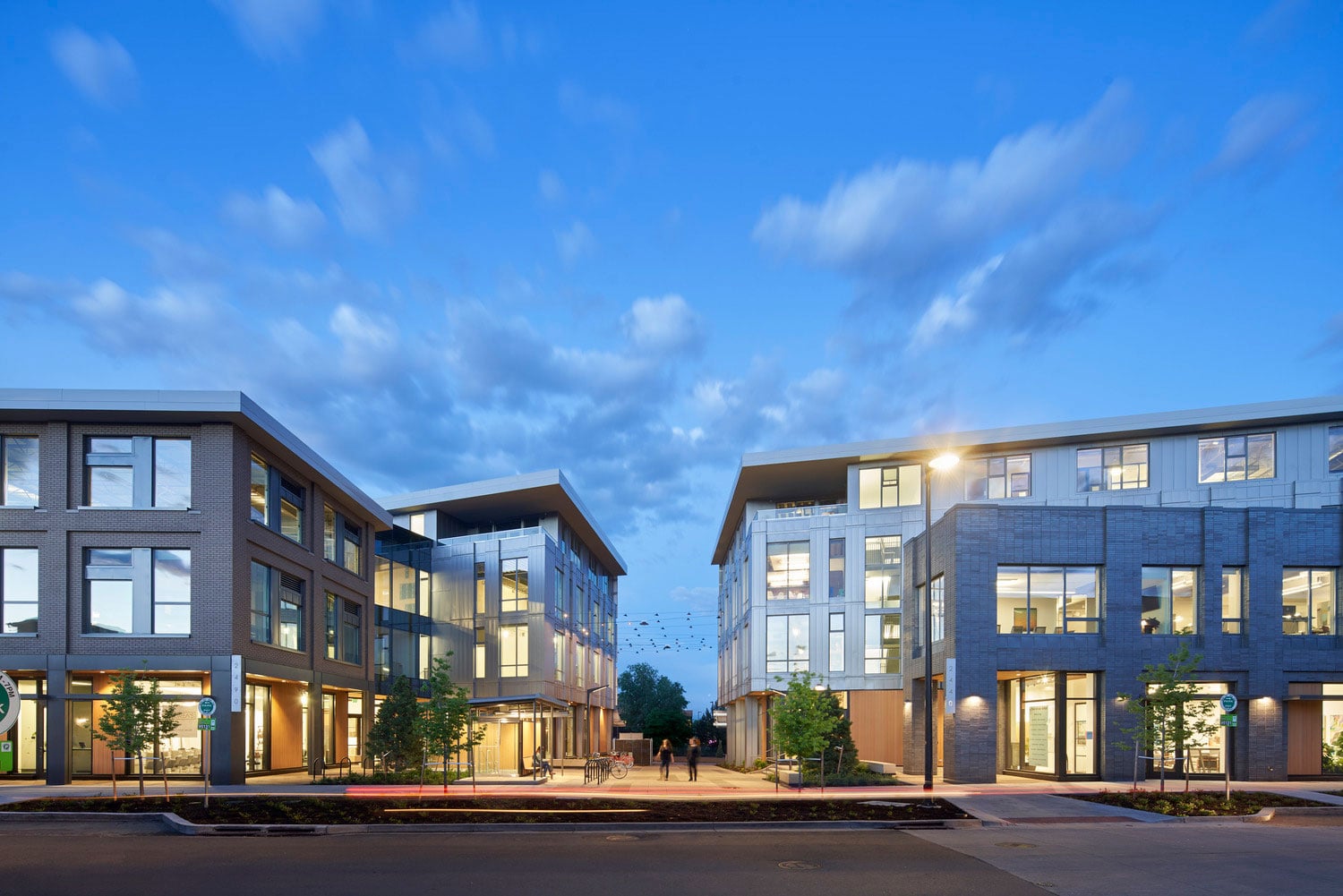
At the Boulder Commons Net Zero Energy Office Building, the client is offering a new model of speculative mixed-use development that yields returns to the occupants, owner, and community. Photo by Bruce Damonte
At the most basic level net zero refers to a state in which the amount of emissions produced are balanced by the amount removed from the atmosphere. The term “net zero” is most often used in relation to the balancing of carbon emissions, but it technically refers to the balancing of all greenhouse gas (GHG) emissions.
Net zero is often used interchangeably with terms like carbon neutrality and gross zero, though they each have distinctions.
Net Zero vs. Carbon Neutrality
Perhaps the most similar to net zero, carbon neutrality describes the state in which an actor’s net contribution to CO2 emissions—and only CO2 emissions—is zero.
Because carbon neutrality does not include all GHGs it is often treated as an intermediate step toward net zero and is often more lenient when it comes to the percentage of carbon emissions that are offset rather than reduced.
Net Zero vs. Gross Zero
Gross or absolute zero means no GHG emissions are produced; emissions have been reduced entirely to zero and there are no residual emissions that must be balanced or offset.
Gross zero is considered to be a step above net zero and is generally recognized as the ideal end-state target.
Why is Net Zero Important?
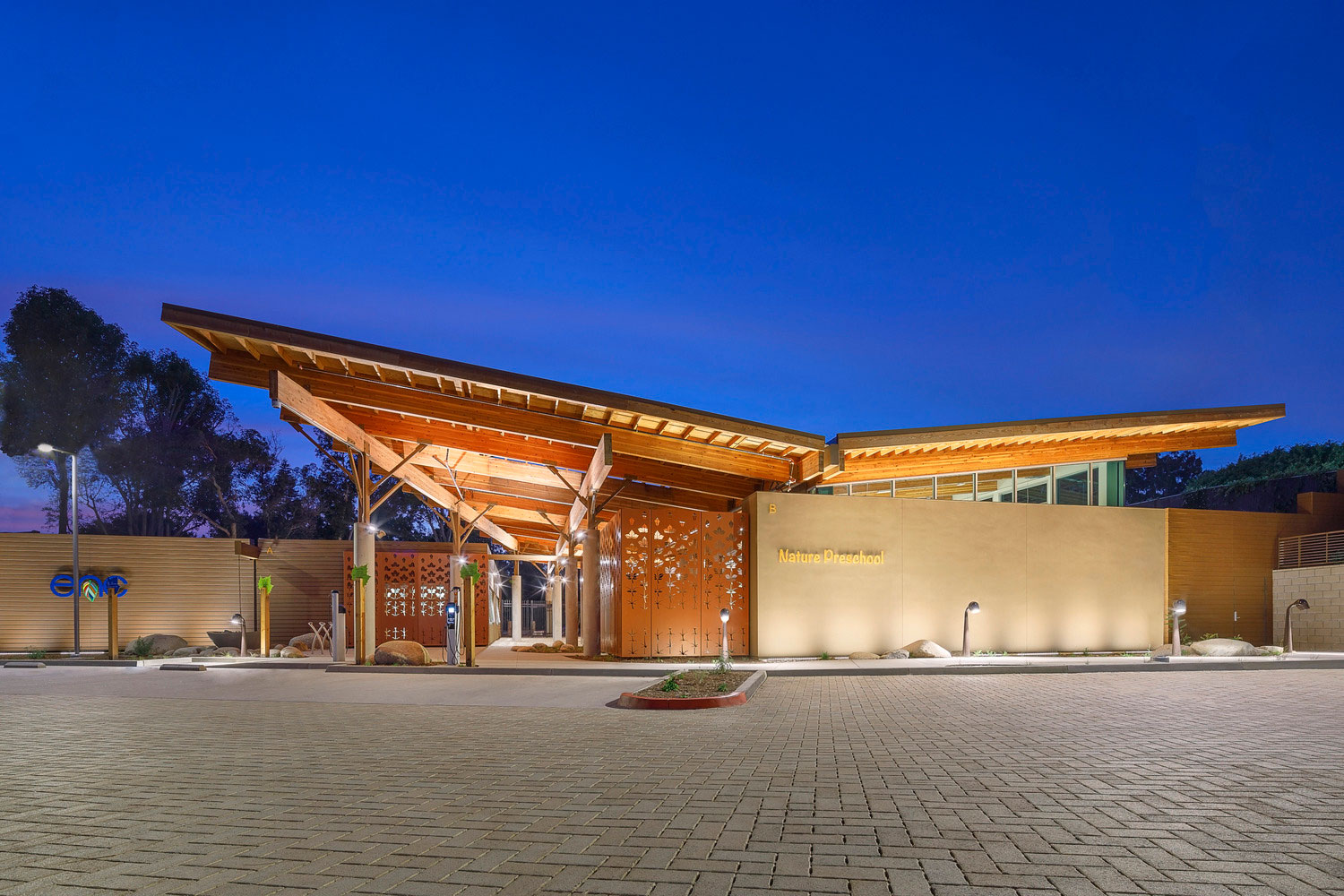
The 8,000-square-foot, three-classroom Environmental Nature Center Preschool is the second LEED Platinum Net Zero building on ENC’s 4.7-acre campus in Newport Beach. Photo by Cris Costea Photography
Carbon dioxide and other GHG emissions are the leading contributors to advanced climate change, followed closely by the destruction of habitats (e.g. forests, grasslands, and oceans) that sequester carbon. If we hope to avoid total climate catastrophe and ensure the planet’s livability for future generations, global temperature increase must be limited to 1.5℃ above pre-industrial levels.
Reducing GHG emissions is integral to mitigating and eventually reversing the worst effects of our drastically changing climate, and achieving net zero at the global scale—particularly with regard to CO2 emissions—is absolutely necessary because it represents the point at which global warming effectively stops. Current estimates suggest that in order to avoid crossing the 1.5℃ threshold, global emissions must be reduced by 45% by 2030 and net zero must be reached by 2050.
The History of Net Zero
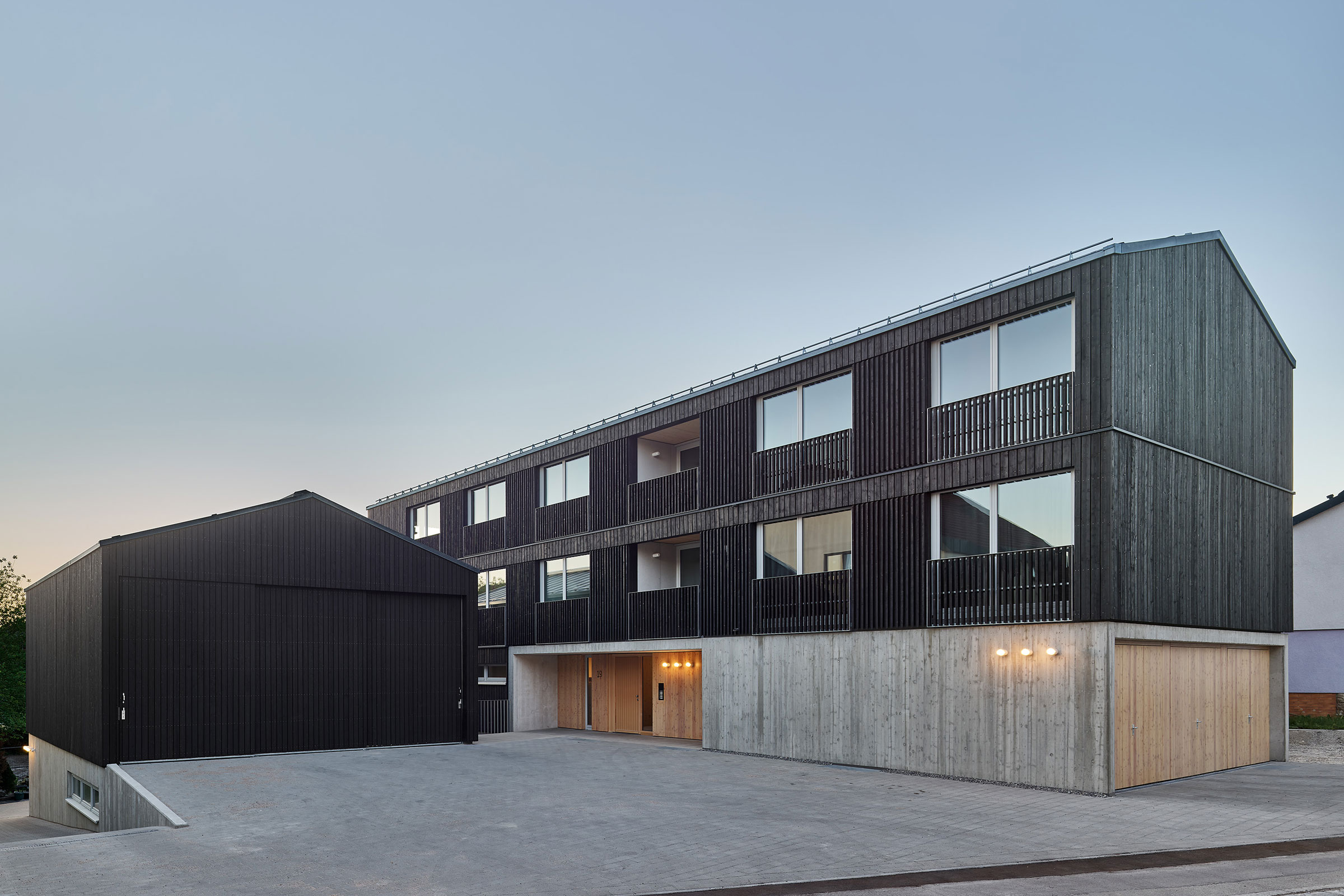
schleicher.ragaller architects’ housing and workshop near Stuttgart, Germany is a net zero building designed to give back to the community. Photo by Zooey Braun Photography
Our modern conceptualization of net zero came about in the late 2000s as a result of scientific research that focused on identifying how the atmosphere, oceans, and the carbon cycle as a whole were being impacted by CO2 emissions. This research concluded that reducing global CO2 emissions to net zero was integral to halting global warming.
This concept of net zero emissions was the fundamental basis upon which the 2015 Paris Climate Agreement’s goal of keeping global warming below 1.5℃ (or the point at which it is considered irreversible) was founded. Most member states that signed the agreement have since made plans to become net zero by 2050—when all entities are encouraged to achieve net zero by—with some setting more ambitious goals of net zero by 2030. Several countries, including Bhutan, Gabon, and Panama, have already reached net zero, or even net-negative, status.
Statements regarding the efficacy of net zero were also included in the Intergovernmental Panel on Climate Change’s (IPCC) 2018 Special Report on Global Warming of 1.5℃. In this report the IPCC expressed high confidence in the notion that achieving and sustaining net zero anthropogenic CO2 emissions and declining net non-CO2 radiative forcing at the global level would stop anthropogenic global warming in its tracks.
Pathways to Net Zero

The Advanced Technology and Applied Science building at Saddleback College is designed to achieve Zero Net Energy with a LEED Gold rating using passive strategies integrated into the design of the building to minimize energy consumption. Site orientation, geometric relationships between adjacent masses, and an aggressive self-shading strategy all lower loads on the building. Rendering courtesy of HED
There are three core pathways to achieving net zero across various sectors and industries: emissions reduction, atmospheric emissions removal, and the purchasing of carbon offsets/credits.
Emissions Reduction
Emissions reduction, the most effective pathway to net zero, refers to when companies and other global actors actively take steps to reduce their emissions using science-based strategies. The most effective emissions reduction strategy is transitioning away from fossil fuel energies and investing in sustainable, renewable energy sources—a process known as decarbonization—followed by improving the overall energy efficiency of existing systems, processes, and products.
Any emissions that cannot be cut, or that would be extremely technologically impractical to reduce, are referred to by experts as “residual emissions” and must be balanced by either removal or offset programs.
Emissions Removal & Storage
Companies can also pursue emissions removal initiatives—or deliberate activities that actively remove or absorb GHGs from the atmosphere and store them for the long term. Emissions removal initiatives are only allowed under BSI and ISO standards if they have the same permanence as the GHGs they remove. Permanence means the proposed program stores captured GHGs for the same period of time those GHGs would naturally persist in the atmosphere.
Because different greenhouse gasses have different lifespans, removal projects can vary in the length of time they must last for. A carbon dioxide removal initiative, for instance, would have to last between 300 and 1,000 years, whereas a program that removes nitrous oxide would only have to last between 100 and 130 years.
Some of the most common emissions removal/storage strategies include reforestation, agroforestry, coastal wetland restoration, ocean fertilization, carbon sequestration in grasslands and croplands, biochar carbon removal, and direct air carbon capture.
Carbon Offsets & Credits
Companies may also purchase carbon credits that “offset” their own emissions. While controversial (read more below), these credits allow governments, businesses, and individuals to compensate for their own GHG emissions by actively supporting or funding projects that avoid, remove, or reduce emissions elsewhere.
The credit itself is a type of transferable financial instrument that may be bought or sold after certification by a government or independent certification entity. One carbon credit represents the removal, reduction, or avoidance of exactly one ton of carbon dioxide or its carbon dioxide-equivalent.
Support of future carbon offset programs are treated as a type of note payable. That is, the purchaser of the credit agrees to pay carbon market rate for the credits and receives a guarantee that the purchaser’s present GHG emissions will be offset by an equal amount some time in the future. Carbon offset programs can take the form of any of the aforementioned carbon reduction and removal strategies.
Criticisms of Net Zero

The 17-story, mixed-use One Boston Wharf Road project is set to become Boston’s largest net zero carbon facility when it’s completed in 2024. Photo courtesy of Henning Larsen
Most criticisms of net zero focus on emissions removal and offset strategies, as many climate scientists believe encouraging these pathways only delays the adoption of crucial emissions reduction programs. This is especially true of offset credits, which are often accused of protecting a “business as usual” mindset and promoting greenwashing rather than serving as stepping stones towards widespread emissions reduction efforts.
There are also concerns regarding the current climate pledges set forth by governments, many of which fall far short of what is required to actually reach net zero by the year 2050. Indeed, the current plans of almost all member states who signed the Paris Climate Agreement would actually lead to a 9% increase in global GHG emissions by 2030, according to the United Nations Net Zero Coalition.
In order to ensure the pledges and commitments made by governments, businesses, and other institutions are actually turned into action, stronger criteria and standards need to be developed and harsher penalties must be issued to those entities which fail to set meaningful net zero goals.
Net Zero in the Built Environment
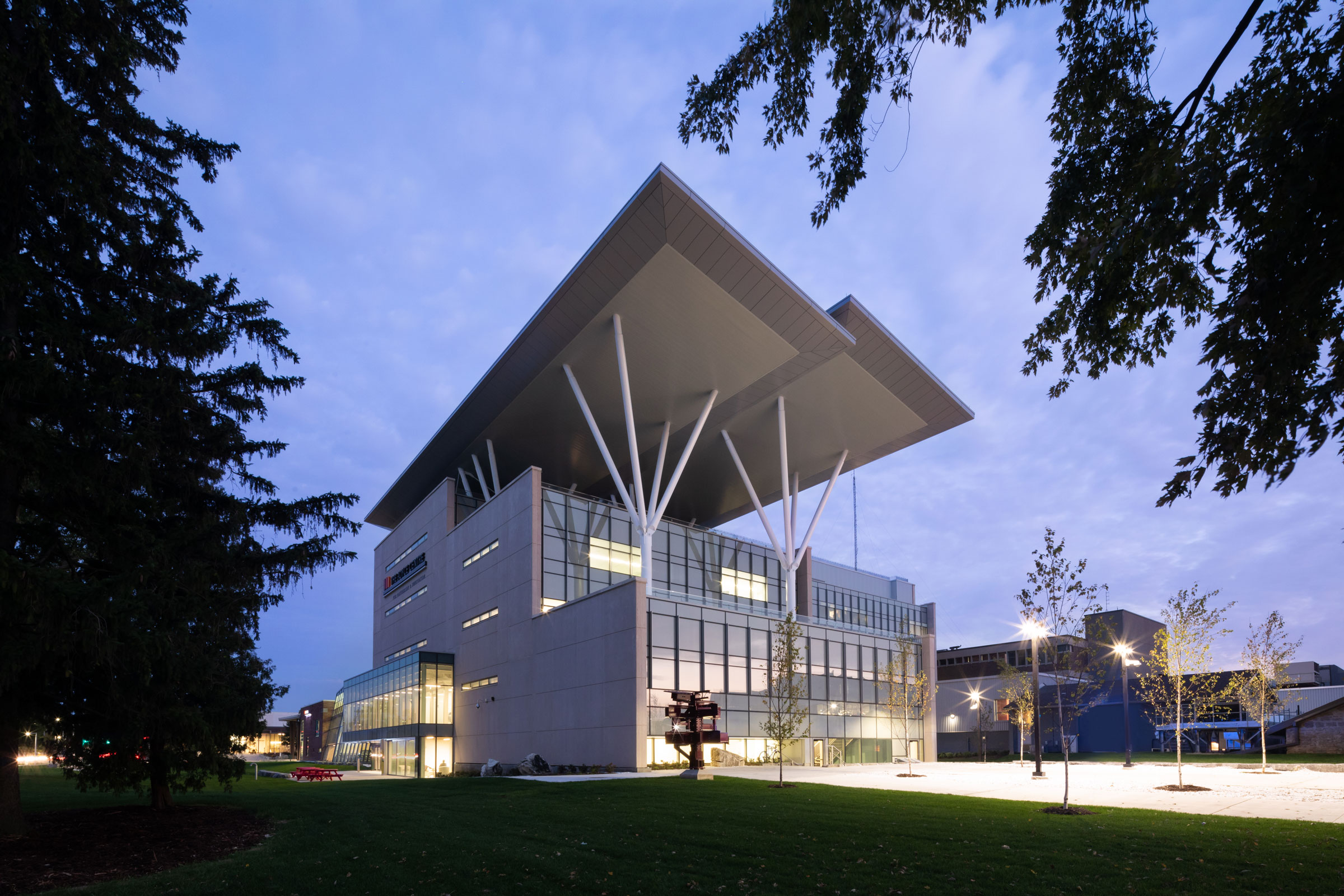
The Joyce Centre for Partnership & Innovation is a net zero building. Photo courtesy of B+H Architects
To achieve net zero emissions at the global scale, all nation states, industries, corporations, companies, and other entities must do their part to reduce emissions. This is especially true of the built environment, which accounts for approximately 40% of all GHG emissions and produces roughly 14.4 metric gigatons of CO2e annually.
It is for this reason that many architects, engineers, and developers have begun to design greener, more efficient buildings that drastically reduce energy consumption and subsequent emissions. A number of green building organizations have even created certification programs to encourage the implementation of net zero design strategies. These include LEED Zero, the ILFI’s Zero Energy Certification, the Green Building Alliance’s Net Zero Energy Designation, and the New Buildings Institute’s (NBI) Net Zero Energy Verification.
Best practices for achieving net zero in the built environment include:
- Utilizing building performance modeling software. To better understand a building’s projected energy use, architects and engineers are encouraged to use building performance modeling software early on in the design process to help simulate everything from energy and daylight models to hygrothermal modeling.
- Switching to renewable energy. In order for a building to achieve net zero status, it must be capable of producing, at the very least, a portion of its own energy via renewable sources; solar is the most common and often the easiest to integrate, but both geothermal and even wind power are becoming increasingly popular.
- Integrating passive design systems. Buildings that leverage natural phenomena to their advantage by way of passive systems consume far less energy than those that rely on active systems; common passive design strategies include natural ventilation, passive solar design, daylighting, and so on.
- Improving insulation and air sealing. A building’s overall energy-efficiency can be improved further through the use of rigorous insulation and air sealing technology to create an airtight building envelope that prevents heat from entering or escaping.
- Installation of energy-efficient appliances. Installing appliances and other mechanical systems with low-energy requirements—such as those certified by ENERGY STAR—can help reduce a structure’s overall energy demands.
- Long-term monitoring. After completion, it’s important to monitor a building’s performance and energy use for the long-term, as this can help identify problem areas that may be improved upon and reduce emissions production even further.
The methods listed above represent some of the best strategies for designing net zero buildings and reducing energy consumption—and therefore emissions—in the built environment.
5 Net Zero Building Examples
Here are a few examples of successful net zero buildings from around the country
1. Montgomery Middle School, Chula Vista, CA
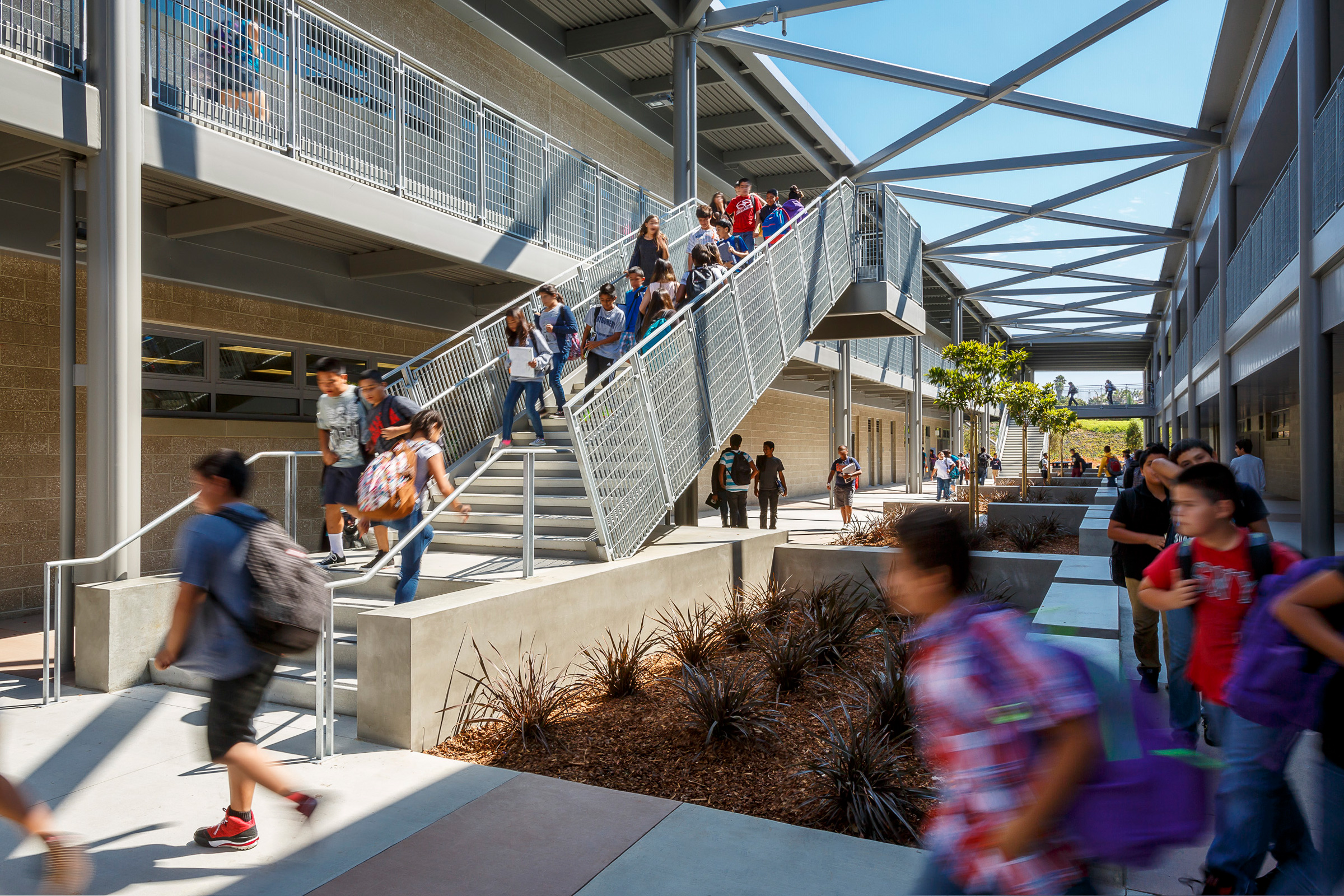
Montgomery Middle School achieved net zero status as well as LEED Platinum-certification. Photo courtesy of LPA Design Studio
Originally built in the 1970s, the Montgomery Middle School in Chula Vista underwent an extensive expansion in 2015 to address existing water damage and accommodate a growing population. Designed by LPA Design Studios, this 37,500-square-foot addition achieved LEED Platinum certification in large part thanks to its goal of attaining net zero energy, made possible by a 217-kW photovoltaic system that spans the school’s roof.
To reduce energy consumption from the outset LPA chose to orient the school on an east-west axis, reducing the amount of harsh exposure from the south, which in turn reduces solar heat gain and the need for mechanical air conditioning. That’s not to say that the school doesn’t have HVAC units. In fact, each classroom has its own high-efficiency HVAC unit that is linked to the campus’ energy management system.
Montgomery Middle School also features an innovative stormwater management system. Because of the school’s geographic location runoff quickly ends up in the ocean, meaning a stormwater treatment system was a must. LPA’s solution was to include a bioswale—or a kind of channel that naturally slows and filters water before redirecting it elsewhere.
Other sustainable features include natural landscaping with drought-resistant plants, light-colored surfaces to combat the urban heat island effect, energy-efficient lighting systems, light shelves that reflect light deeper into the building, and low-flow bathroom fixtures to conserve water.
2. Pahranagat National Wildlife Refuge Visitor Center, Alamo, NV
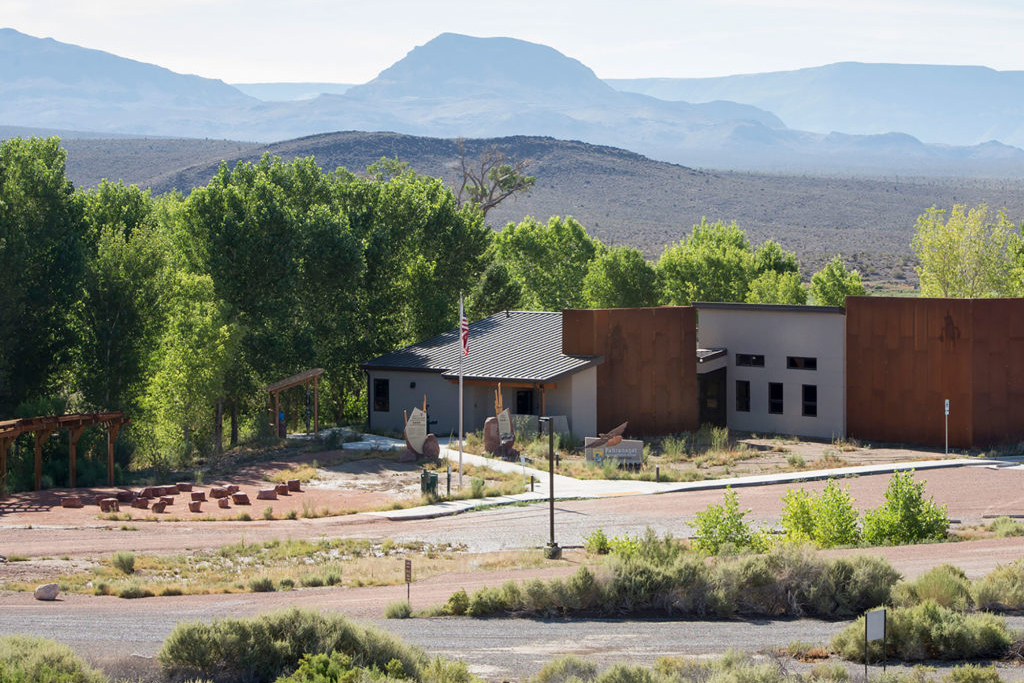
The Pahranagat National Wildlife Refuge Visitor Center in Nevada is net zero. Photo courtesy of Cushing Terrell
Designed by Cushing Terrell, the Pahranagat National Wildlife Refuge Visitor Center in Alamo is an inspiring example of how net zero buildings can not only reduce energy consumption but also promote cultural and ecological sustainability. “It’s a beautiful, modern facility that supports, rather than interrupts, its environment,” Shawn Pelowitz, director of Cushing Terrell’s Government Design Studio, previously wrote for gb&d.
Inspired by the surrounding landscape and the history of the local Indigenous nations, the Pahranagat National Wildlife Refuge Visitor Center utilizes an east-facing entryway and incorporates banding to express the red-tailed hawk, the latter of which features in the oral traditions of the Nuwuvi or Southern Paiute peoples and whose image graces the center’s monument sign.
To achieve net zero the design team used architectural and energy modeling software early in the design process to inform the center’s optimal orientation, building materials, massing, and systems. The building also features upgraded insulation, a ground-source geothermal HVAC system, daylight harvesting, and roof-mounted solar photovoltaic panels. The visitor center also achieved LEED Silver.
3. The Exploratorium, San Francisco![]()
![]()

The Exploratorium’s move to Pier 15 provides a prime waterfront location for this internationally acclaimed museum of science and perception. The complexity of the program was matched by the challenge of rehabilitating an existing historic structure in the most energy-efficient manner possible. To that end, the building takes advantage of the original pier building’s natural lighting and the water of the Bay for cooling and uses materials that are both sustainable and durable enough to withstand a harsh maritime climate. The result is the country’s largest Net Zero Energy museum. Photo by Bruce Damonte
The Exploratorium houses more than 1,000 exhibits. Originally located in the Palace of Fine Arts, it relocated in 2013 to Piers 15 and 17 on San Francisco’s waterfront.
Designed by EHDD, the new Exploratorium officially received Net Zero Energy verification from the NBI in November 2023, making it the largest net zero energy use museum in the country. It was awarded LEED Platinum in 2014.
The museum achieved net zero in large part thanks to its onsite renewable energy production. Since opening in 2013 the Exploratorium has generated 85% of its own energy via a 1.3-megawatt SunPower solar grid composed of 5,874 high-efficiency rooftop-mounted solar panels preventing approximately 16,186 tons of carbon dioxide from entering the atmosphere. Today, the museum produces more energy than it uses on a yearly basis.
Other low-energy design strategies include the use of insulated windows with low-emissivity glass, LED light fixtures, extensive daylighting solutions, an energy-efficient natural convection-based displacement ventilation system, and a bay water heating and cooling system that utilizes geothermal exchange to regulate the building’s temperature.
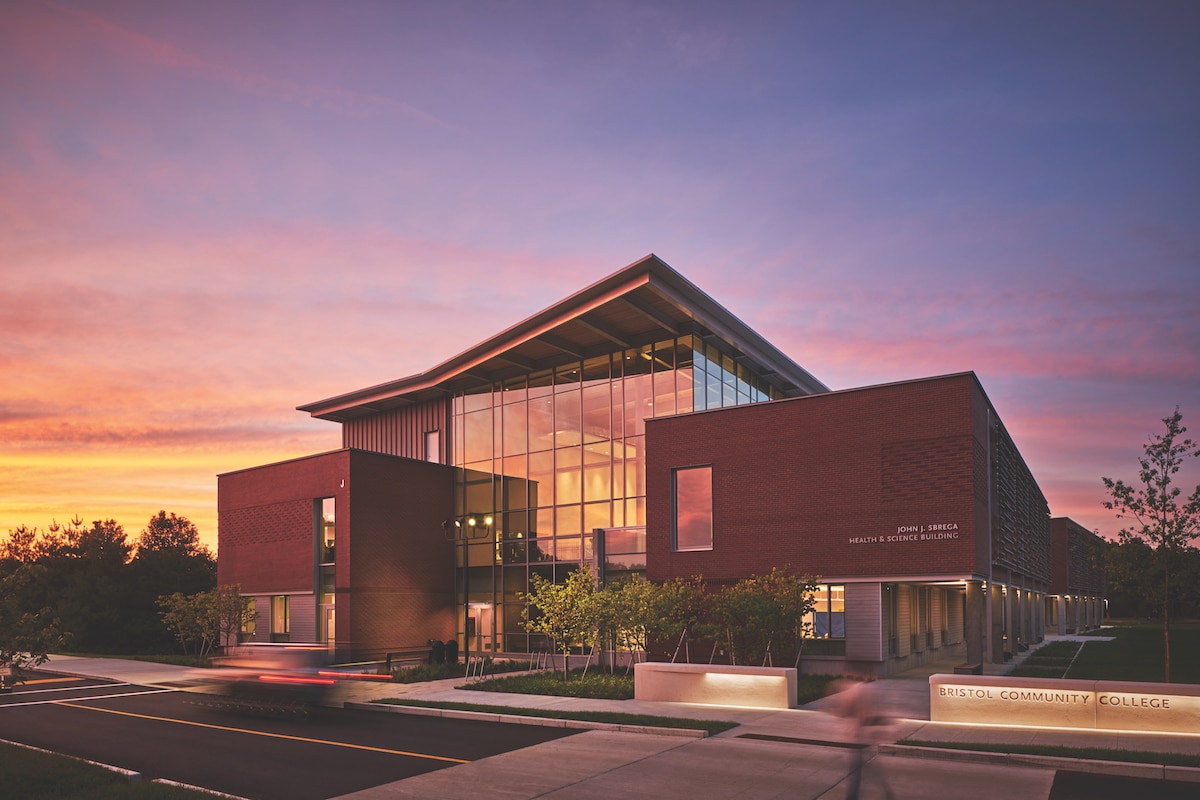
Reduced plug loads, a wider indoor temperature range, enthalpy wheel heat recovery, and filtered fume hoods are among the green building features that helped this health and science center achieve net zero. Photo by Edward Caruso
Bristol Community College is committed to achieving carbon neutrality by the year 2050—and the campus’ latest addition, the John J. Sbrega Health & Science Building, is testament to the college’s ongoing efforts to reduce its GHG emissions.
Designed by Sasaki, the John S. Sbrega Health & Science Building is one of the largest net zero buildings in the region and proves that energy-saving strategies can be implemented even in spaces that require more advanced safety measures than the average building.
“I’ve had people ask me why the chemistry building is the place to reduce energy, when safety is paramount,” Thomas Simister, a senior associate at Sasaki, told gb&d in a previous article. “I would completely agree with that, but we also say that unless we push ourselves technologically and behaviorally, we’re not going to make a dent in our energy consumption overall. There are ways to reduce energy smartly, even in science buildings like these.”
Take the building’s labs, for example. In order to maintain adequate air quality, fume hoods were needed to filter out chemical fumes—traditional fume hoods, however, require a large amount of electricity to run. Sasaki circumvented this issue by choosing to install energy-efficient fume hoods that filter chemical fumes in a self-contained system.
Sasaki was able to reduce the building’s energy use even further by implementing a natural ventilation system, maximizing daylighting solutions, installing an enthalpy wheel heat recovery system, and dramatically decreasing lighting and plug loads. A high-performance, airtight building envelope further serves to curb excess energy usage while the campus’ 3.2-megawatt solar array supplies the John J. Sbrega Health & Science Building with enough renewable energy so as to completely eliminate the need for fossil fuel-based heating and cooling.
5. The David and Lucile Packard Foundation Headquarters, Los Altos, CA

The new headquarters for The David and Lucile Packard Foundation was designed to serve as a catalyst for broader organizational sustainability initiatives by achieving net zero energy use and LEED Platinum certification. Photo by Jeremy Bitterman
In Los Altos, the EHDD-designed David and Lucile Packard Foundation Headquarters is both LEED Platinum and Net Zero Energy Building–certified.
From the very beginning the building was designed with the planet’s health and the wellbeing of the foundation’s employees in mind, even down to the sustainable building materials used in its construction. Low-VOC flooring, paint, adhesive, and other materials were used wherever possible and all wood used on the premises was specified for its FSC-certification. In total, however, very few new materials were even needed, as approximately 95% of the headquarters’ materials were recycled from pre-existing buildings.
To achieve net zero a rooftop grid of 915 solar panels produces all of the energy the building consumes, while effective daylighting strategies and innovative chilled beam technology reduce the need for artificial lighting and mechanical heating and cooling.
To meet LEED water conservation requirements—that is, a 40% reduction in water consumption compared to traditional buildings—the David and Lucile Packard Foundation Headquarters features a green roof, rain gardens, and permeable pavement to mitigate stormwater runoff, as well as a 20,000 gallon rainwater storage tank.
This collected rainwater is then used to flush toilets and for landscape irrigation via a smart-controlled drip-line that only waters when and where it’s necessary—but seeing as 90% of the plants grown at the headquarters are native to California, supplementary irrigation is rarely needed.

